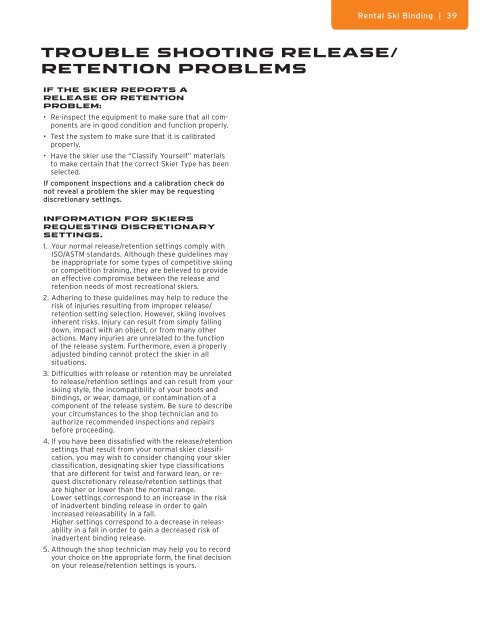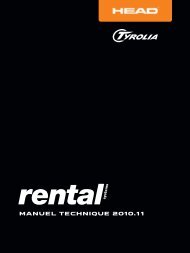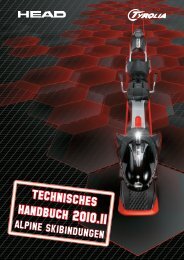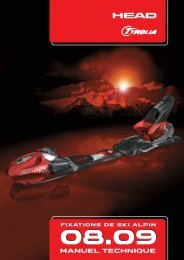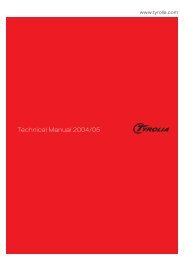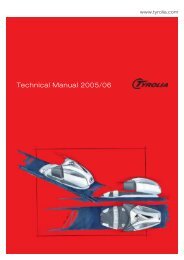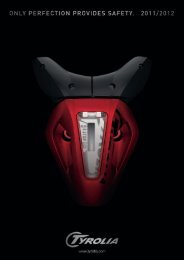You also want an ePaper? Increase the reach of your titles
YUMPU automatically turns print PDFs into web optimized ePapers that Google loves.
39 | Rental Ski Binding<br />
TROUBLE SHOOTING RELEASE/<br />
RETENTION PROBLEMS<br />
IF THE SKIER REPORTS A<br />
RELEASE OR RETENTION<br />
PROBLEM:<br />
• Re-inspect the equipment to make sure that all components<br />
are in good condition and function properly.<br />
• Test the system to make sure that it is calibrated<br />
properly.<br />
• Have the skier use the “Classify Yourself” materials<br />
to make certain that the correct Skier Type has been<br />
selected.<br />
If component inspections and a calibration check do<br />
not reveal a problem the skier may be requesting<br />
discretionary settings.<br />
INFORMATION FOR SKIERS<br />
REQUESTING DISCRETIONARY<br />
SETTINGS.<br />
1. Your normal release/retention settings comply with<br />
ISO/ASTM standards. Although these guidelines may<br />
be inappropriate for some types of competitive skiing<br />
or competition training, they are believed to provide<br />
an effective compromise between the release and<br />
retention needs of most recreational skiers.<br />
2. Adhering to these guidelines may help to reduce the<br />
risk of injuries resulting from improper release/<br />
retention setting selection. However, skiing involves<br />
inherent risks. Injury can result from simply falling<br />
down, impact with an object, or from many other<br />
actions. Many injuries are unrelated to the function<br />
of the release system. Furthermore, even a properly<br />
adjusted binding cannot protect the skier in all<br />
situations.<br />
3. Difficulties with release or retention may be unrelated<br />
to release/retention settings and can result from your<br />
skiing style, the incompatibility of your boots and<br />
bindings, or wear, damage, or contamination of a<br />
component of the release system. Be sure to describe<br />
your circumstances to the shop technician and to<br />
authorize recommended inspections and repairs<br />
before proceeding.<br />
4. If you have been dissatisfied with the release/retention<br />
settings that result from your normal skier classification,<br />
you may wish to consider changing your skier<br />
classification, designating skier type classifications<br />
that are different for twist and forward lean, or request<br />
discretionary release/retention settings that<br />
are higher or lower than the normal range.<br />
Lower settings correspond to an increase in the risk<br />
of inadvertent binding release in order to gain<br />
increased releasability in a fall.<br />
Higher settings correspond to a decrease in releasability<br />
in a fall in order to gain a decreased risk of<br />
inadvertent binding release.<br />
5. Although the shop technician may help you to record<br />
your choice on the appropriate form, the final decision<br />
on your release/retention settings is yours.<br />
Rental Ski Binding | 39


